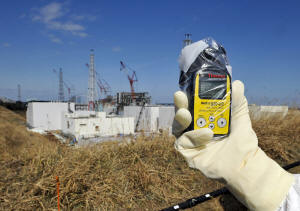Slightly radioactive soil from Fukushima will be used in the prime
minister's flower beds
[May 28, 2025]
By MARI YAMAGUCHI
TOKYO (AP) — Japan said Tuesday it plans to use some slightly
radioactive soil stored near the tsunami-wrecked Fukushima nuclear plant
on flower beds at Prime Minister Shigeru Ishiba’s office to show it is
safe to reuse.
The soil was removed from across the Fukushima prefecture as part of
decontamination work following the 2011 nuclear disaster and has since
been in interim storage. Some of it has since reached levels safe enough
for reuse, officials say.
Using the soil at Ishiba's office in Tokyo is aimed at reassuring the
public it is safe. The government said that it plans to reuse the soil
for flower beds and other purposes within the grounds of government
agencies. The plan is based on guidelines set by the Environment
Ministry in March and endorsed by the International Atomic Energy
Agency.
The timing and other details for the soil use still need to be worked
out and the government is expected to compile a roadmap for the project
around the summer.
The Fukushima disaster resulted in large amounts of radioactive
materials spewing out from the plant, polluting surrounding areas,
leaving some areas still uninhabitable and requiring further
decontamination work.
Japan is stuck with large volumes of the dirt, chopped trees and other
debris collected during intensive decontamination work. It has 14
million cubic meters of dirt and other materials — enough to fill 11
baseball stadiums — stored at a sprawling outdoor facility straddling
the towns of Futaba and Okuma, near the Fukushima plant. The soil does
not include any from inside the plant.
The government has pledged to find disposal sites for the soil outside
of the prefecture by 2045, with officials suggesting low risk material
could be used to build roads and in other public works projects across
the country.
[to top of second column]
|

A radiation monitor indicates 131.00 mSv per hour near Unit 3 and 4
reactor buildings at Tokyo Electric Power Co.,'s tsunami-crippled
Fukushima Dai-ichi nuclear power station in Okuma, Fukushima
prefecture, northeastern Japan, Tuesday, Feb. 28, 2012. (AP Photo/Kimimasa
Mayama, Pool, File)

Chief Cabinet Secretary Yoshimasa Hayashi, at the soil task force
meeting, called for a government-wide effort to promote
understanding for the soil use for reconstruction projects and to
show good examples, starting with the Prime Minister's Office.
The Environment Ministry said that the soil will be used as
foundation material and safely covered with top soil thick enough to
keep radiation at negligible levels.
But there is much public unease. The government has already been
forced to discontinue a plan to experiment using some of the soil in
flower beds at several public parks in and around Tokyo following
protests.
The IAEA is providing assistance with the Fukushima decommissioning
process, which requires removing more than 880 tons of melted fuel
debris.
In 2023 Japan began discharging treated radioactive wastewater from
the plant into the sea to reduce the risk of accidental leaks and to
make space to build facilities needed for melted fuel removal.
All contents © copyright 2025 Associated Press. All rights reserved |